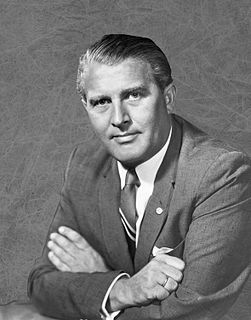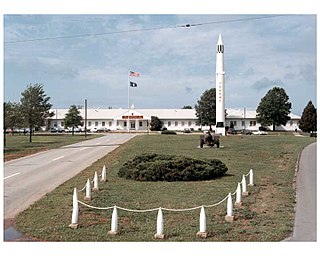
Wernher Magnus Maximilian Freiherr von Braun was a German-American aerospace engineer and space architect. He was the leading figure in the development of rocket technology in Germany and a pioneer of rocket technology and space science in the United States.

The Jupiter-C was an American research and development vehicle developed from the Jupiter-A. Jupiter-C was used for three sub-orbital spaceflights in 1956 and 1957 to test re-entry nosecones that were later to be deployed on the more advanced PGM-19 Jupiter mobile missile.

Redstone Arsenal (RSA) is a United States Army post and a census-designated place (CDP) adjacent to Huntsville in Madison County, Alabama, United States and is part of the Huntsville-Decatur Combined Statistical Area. The Arsenal is a garrison for a number of tenants including the United States Army Materiel Command, Army's Aviation and Missile Command, the Missile Defense Agency of the Department of Defense, and NASA's Marshall Space Flight Center. Many of these units are moving due to decisions by the Defense Base Realignment and Closure Commission. The Redstone Arsenal CDP had a population of 1,946 as of the 2010 census. The base contains a government and contractor workforce that averages 36,000 to 40,000 personnel daily.

The Army Ballistic Missile Agency (ABMA) was formed to develop the U.S. Army's first large ballistic missile. The agency was established at Redstone Arsenal on 1 February 1956, and commanded by Major General John B. Medaris with Wernher von Braun as technical director.

The PGM-11 Redstone was the first large American ballistic missile. A short-range ballistic missile (SRBM), it was in active service with the United States Army in West Germany from June 1958 to June 1964 as part of NATO's Cold War defense of Western Europe. It was the first US missile to carry a live nuclear warhead, in the 1958 Pacific Ocean weapons test, Hardtack Teak. Chief Engineer Wernher von Braun personally witnessed this historic launch and detonation.

Apollo 6, launched on April 4, 1968, was the second A-type mission of the United States Apollo program, an unmanned test of the Saturn V launch vehicle. It was also the final unmanned Apollo test mission.

Cape Canaveral Air Force Station (CCAFS) is an installation of the United States Air Force Space Command's 45th Space Wing.

The Saturn IB was an American launch vehicle commissioned by the National Aeronautics and Space Administration (NASA) for the Apollo program. It replaced the S-IV second stage of the Saturn I with the much more powerful S-IVB, able to launch a partially fueled Apollo command and service module (CSM) or a fully fueled lunar module (LM) into low Earth orbit for early flight tests before the larger Saturn V needed for lunar flight was ready.

The John C. Stennis Space Center (SSC) is a NASA rocket testing facility. It is located in Hancock County, Mississippi, on the banks of the Pearl River at the Mississippi–Louisiana border. As of 2012, it is NASA's largest rocket engine test facility. There are over 30 local, state, national, international, private, and public companies and agencies using SSC for their rocket testing facilities.

The PGM-19 Jupiter was the first nuclear tipped, medium-range ballistic missile (MRBM) of the United States Air Force (USAF). It was a liquid-propellant rocket using RP-1 fuel and LOX oxidizer, with a single Rocketdyne LR70-NA rocket engine producing 667 kN of thrust. It was armed with the 1.44 megaton W49 nuclear warhead. The prime contractor was the Chrysler Corporation.

The Nuclear Engine for Rocket Vehicle Application (NERVA) was a U.S. nuclear thermal rocket engine development program that ran for roughly two decades. NERVA was a joint effort of the U.S. Atomic Energy Commission (AEC) and NASA, managed by the Space Nuclear Propulsion Office (SNPO) until both the program and the office ended at the end of 1972.
The Vanguard rocket was intended to be the first launch vehicle the United States would use to place a satellite into orbit. Instead, the Sputnik crisis caused by the surprise launch of Sputnik 1 led the U.S., after the failure of Vanguard TV3, to quickly orbit the Explorer 1 satellite using a Juno I rocket, making Vanguard I the second successful U.S. orbital launch.

The Aerojet Rocketdyne RS-68 is a liquid-fuel rocket engine that uses liquid hydrogen (LH2) and liquid oxygen (LOX) as propellants in a gas-generator power cycle. It is the largest hydrogen-fueled rocket engine ever flown.

The United States Army Aviation and Missile Command is primarily responsible for life cycle management of army missile, helicopter, unmanned ground vehicle and unmanned aerial vehicle weapon system. The central part of AMCOM's mission involves ensuring readiness through acquisition and sustainment support for aviation systems, missile systems, and test, measurement, and diagnostic equipment (TMDE) throughout their life cycle. The command is headquartered at Redstone Arsenal in Huntsville, Alabama.

Redstone Army Airfield or Redstone AAF is a military airport located at Redstone Arsenal, six miles southwest of the city of Huntsville in Madison County, Alabama, United States. The airfield was originally constructed for munitions testing for the U.S. Army and the U.S. Army Air Forces through the 6th AAF Base Unit. It is currently used to support the U.S. Army Aviation and Missile Command, NASA, and other U.S. government aviation and space activities.

The Hermes project was started in response to Germany's rocket attacks in Europe. Project Hermes was to determine the missile needs of army field forces. "Accordingly the Ordnance Department entered into a research and development contract with the General Electric Company on 20 November 1944. "This contract authorized the General Electric Company to seek the development of long-range missiles that could be used against both ground targets and high-altitude aircraft. The contractor agreed to perform investigations, research, experiments, design, development, and engineering work in connection with the development of long-range missiles for use against ground targets and high-altitude aircraft." General Electric was also to investigate ramjets, solid rocket motors, liquid propellant rocket engines, and hybrid propellants. "The contract also required the General Electric Company to develop remote control equipment, ground equipment, fire control devices, and homing devices."

The Redstone Test Stand or Interim Test Stand was used to develop and test fire the Redstone missile, Jupiter-C sounding rocket, Juno I launch vehicle and Mercury-Redstone launch vehicle. It was declared an Alabama Historic Civil Engineering Landmark in 1979 and a National Historic Landmark in 1985. It is located at NASA's George C. Marshall Space Flight Center (MSFC) in Huntsville, Alabama on the Redstone Arsenal, designated Building 4665. The Redstone missile was the first missile to detonate a nuclear weapon. Jupiter-C launched to test components for the Jupiter missile. Juno I put the first American satellite Explorer 1 into orbit. Mercury Redstone carried the first American astronaut Alan Shepard into space. The Redstone earned the name "Old Reliable" because of this facility and the improvements it made possible.

The Redstone rocket was named for the Redstone Arsenal in Huntsville, Alabama where it was developed. The Redstone family of rockets consisted of a number of American ballistic missiles, sounding rockets and expendable launch vehicles operational during the 1950s and 1960s. The first member of the Redstone family was the PGM-11 Redstone missile, from which all subsequent variations of the Redstone were derived. The Juno 1 version of the Redstone launched Explorer 1, the first U.S. orbital satellite in 1958 and the Mercury-Redstone variation carried the first two U.S. astronauts into space in 1961.
The Mercury-Redstone Launch Vehicle, designed for NASA's Project Mercury, was the first American manned space booster. It was used for six sub-orbital Mercury flights from 1960–61; culminating with the launch of the first, and 11 weeks later, the second American in space. The fourth subsequent Mercury human spaceflights used the more powerful Atlas booster to enter low Earth orbit.

U.S. Army Redstone Test Center, or RTC, is subordinate organization to the United States Army Test and Evaluation Command, a direct reporting unit of the United States Army responsible for developmental testing, independent evaluations, assessments, and experiments of Army aviation, missiles and sensor equipment.




















